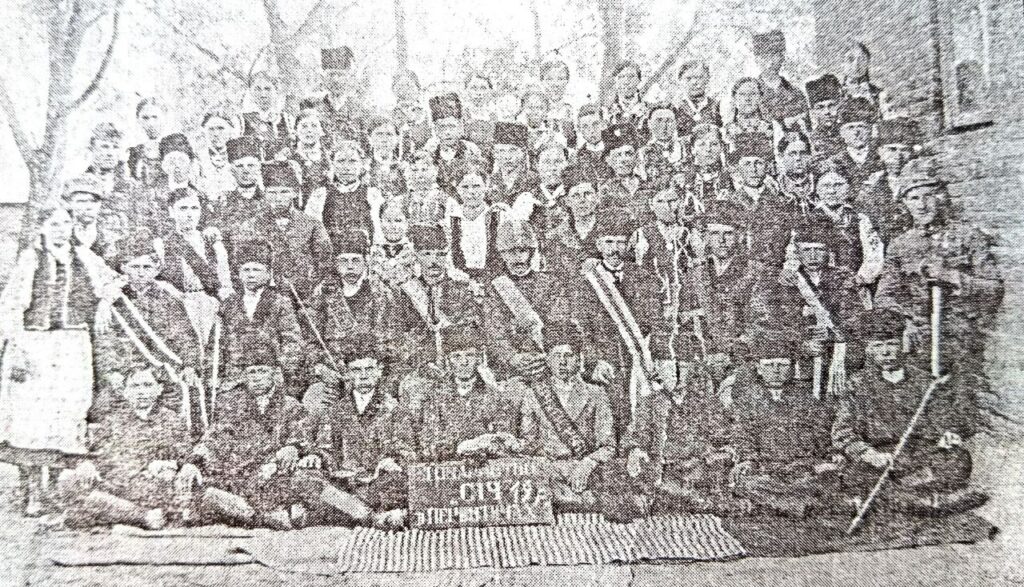Fires are a common occurrence in 19th century Ukrainian villages, where most houses, barns and barns were made of wood with thatched roofs.
In addition, in winter the houses were additionally insulated by making so-called barriers (horizontally knocked down boards between the walls, where various dry vegetation was inserted, mostly hay).
Firefighting has been carried out by the population for many centuries. At the first news of the fire, residents had to flee to its place with personal equipment. Danger was announced due to the ringing of the bell. Due to the lack of appropriate technical means, the necessary knowledge and cohesion, the fire could not be extinguished quickly. This problem required the necessary professional associations, so at the beginning of the XIX century the first fire brigades appeared in Ukraine.
It will be recalled that Yevhen Petrushevych had a law firm in Sokal and was elected to the Austrian parliament from the Sokal-Radekhiv-Brody constituency
The principle of local self-government guarantees the right of residents to unite in professional communities or societies based on certain cultural, historical and ideological values in order to meet their own needs. At the end of the 19th century, fire watch societies appeared in the Sokal region. Educated peasants became the leaders of the societies: teachers, conductors, etc. They were responsible for arranging fires, training members of the society, and taking measures to prevent possible fires.
The newspaper “Dilo” wrote on April 23, 1892 in the column “Fire”: “In the village of Melnyky in the village. The first floor. Sokalsky, burned down on Easter itself three owners actually when they were in church for the evening. Fortunately, there are no more houses in the village, because otherwise with such a big wind, which was then, it would have gone with smoke and the largest village. The fire watchmen from Spasov, Tartakov, Kopytov and Gorbkov deserve recognition, who have now come to the rescue with sikawkas, in addition to the fact that it was the first day of Easter.
Two or three members of the society rode horses on the weekends to see if there were any fires. When smoke or fire was observed, the riders immediately notified the other members of the guard, and those with equipment went to the scene of the fire. The extinguishing process was as follows: the first two took things out of the room, the second extinguished the fire with a sikavka (water pump with a capacity of 3 l / s), the third brought water in buckets, and the fourth watched that the fire did not spread to other buildings. Societies from other villages were involved in firefighting, when the fires became massive and could not be managed alone.
A couple of Sokal residents with ribbons from the Sich Society in 1928. photo by Vita Lyushik
With the beginning of the XX century and the spread of the idea of the right of nations to self-determination, the technical orientation of the society grew into a cultural and ideological aspect, so most members of the fire brigade became members of the Sich, taking over the function of firefighting. “Sich” had 30-40 participants. Most of them were boys, but there were also girls. Organizationally, the Sich consisted of four companies and officers. Each detachment had its own name and corresponding functions in extinguishing the fire: climbers, sycamore, water and sentry. Each detachment was headed by four. The sergeants included a basket maker, a clerk, an osavul, a treasurer, and a obozny (teacher).
We will remind: From history of cultural and educational society “Education”: in 1927 in the Sokal region there were 40 libraries which counted 5568 books
Sich members wore appropriate clothing, which featured a wide belt (ribbon, palm-width) that encircled the skirt or trousers. The ribbons of ordinary members were crimson in color with embroidered gold letters with the inscription “Sich in Gorbkov”. The sergeant wore yellow and blue ribbons.
“Sich” had its crimson flags, on one side of which was a picture of one of the famous Ukrainian historical figures, and on the other – a lion or a Sich star with eight ends.
In addition to extinguishing fires, the society also aimed at educating a healthy educated Ukrainian peasant, so members of the “Sich” held parties (festivals), where they showed motor exercises, demonstrated exercises with sticks or axes (girls – with handkerchiefs), went on forest hikes, held from alcohol consumption, held meetings with readings of abstracts, etc. It was the members of the Sich who built high graves in the villages in honor of their brothers and sisters, who became the basis of the Ukrainian Sich Riflemen and laid down their hearts for the freedom of Ukraine.
As for the cities in the Sokal region, there were also relevant brigades, which were created on the basis of local councils – town halls, which, according to Magdeburg law, were concerned with local self-government issues, financially providing the relevant structures. They had the appropriate movement – carts with ladders, buckets, water tanks. In honor of firefighters in Tartakov was erected a monument to the patron saint of firefighters – St. Florian (now destroyed, in its place stands the figure of the Virgin Mary on the occasion of the 600th anniversary of the first written mention of the village of Tartakiv). By the way, there are only 4 monuments to the saint on the territory of Ukraine.

